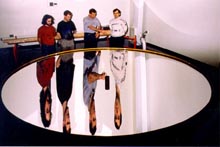Jul 5 2007
An international team including researcher Ermanno Borra, from Université Laval's Center for Optics, Photonics, and Laser, has taken another step toward building a liquid telescope on the moon.
 3.7 meter diameter liquid mirror at Laval University. The liquid is mercury. There are no detectable mercury vapors in the air because a thin transparent layer of oxide covers the surface. Photo Credit: Guy Plante (Laval).
3.7 meter diameter liquid mirror at Laval University. The liquid is mercury. There are no detectable mercury vapors in the air because a thin transparent layer of oxide covers the surface. Photo Credit: Guy Plante (Laval).
The researchers have found a combination of materials that allows the creation of a highly reflective liquid mirror capable of functioning even under harsh lunar conditions. The details of the discovery made by Borra and his colleagues will be published in the June 21 edition of Nature.
Liquid mirror telescopes differ from conventional telescopes by their primary mirrors—the ones that gather and focus light—which are made from a reflective liquid instead of polished glass. Poured into a spinning container, the liquid spreads out and forms a thin, perfectly smooth, and parabolic shape that can be used as a telescope mirror.
In a 1991 paper published in the Astrophysical Journal, Professor Borra had suggested the building of a liquid telescope on the moon. In that paper , Borra demonstrated the practical and economic advantages of liquid mirror telescopes over their conventional counterparts and explained how an observatory free from the Earth's atmospheric disturbance could further our understanding of the early universe.
The project, which seemed almost like science-fiction at the time, gained renewed interest in 2004 when it received financial support from the NASA Institute for Advanced Concepts, an organization which funds projects that can potentially push back the limits of science and space technology.
The project's main challenge consisted in finding a liquid capable of resisting the conditions on the moon's surface and functioning in temperatures required for infrared observations, i.e. below -143 degrees Celsius.
In their Nature article, the researchers explain how they successfully coated an ionic liquid with silver by vaporizing it in a vacuum, something never achieved before in the field of optics. The resulting silver layer is perfectly smooth, highly reflective, remains stable for months, and the ionic liquid on which it lies does not evaporate.
The liquid mirror envisioned for the lunar telescope would be 20 to 100 meters in diameter, making it up to 1,000 times more sensitive than the proposed next generation of space telescopes.
Such a lunar telescope will not be available to researchers in the near future, admits Borra. “However, if we hadn't found the solution described in our article in Nature, it would have meant the end of the whole project.”